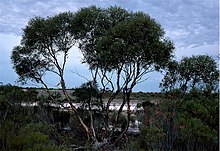| Salt lake mallee | |
|---|---|

| |
| Eucalyptus halophila near Esperance | |
| Scientific classification | |
| Kingdom: | Plantae |
| Clade: | Tracheophytes |
| Clade: | Angiosperms |
| Clade: | Eudicots |
| Clade: | Rosids |
| Order: | Myrtales |
| Family: | Myrtaceae |
| Genus: | Eucalyptus |
| Species: | E. halophila |
| Binomial name | |
| Eucalyptus halophila D.J.Carr & S.G.M.Carr | |
Eucalyptus halophila, also known as salt lake mallee, is a species of mallee or a shrub, that is endemic to Western Australia. It has smooth white and grey bark, sometimes rough and fibrous on the lower trunk, linear to narrow elliptic adult leaves, flower buds usually in grows of seven, white flowers and shortened spherical to barrel-shaped fruit.


Description
Eucalyptus halophila is a shrub or mallee that typically grows to a height of 1 to 4 metres (3 to 13 ft), sometime to 7 m (23 ft), or a shrub up to 2 m (6 ft 7 in) tall, and forms a lignotuber. It has smooth white and pale grey bark, sometimes with fibrous bark on the lower half of its stems. Young plants and coppice regrowth have leaves that are linear, 40–85 mm (1.6–3.3 in) long and 3–6 mm (0.12–0.24 in) wide. Adult leaves are linear to narrow elliptic, the same dull green colour on both sides, 50–80 mm (2.0–3.1 in) long and 5–12 mm (0.20–0.47 in) wide on a petiole 3–9 mm (0.12–0.35 in) long. The flower buds are arranged in leaf axils in groups of seven, sometimes three, on an unbranched peduncle 5–13 mm (0.20–0.51 in) long, the individual buds on pedicels 2–3 mm (0.079–0.118 in) long. Mature buds are pear-shaped, 4–5 mm (0.16–0.20 in) long and 3–5 mm (0.12–0.20 in) wide with a conical to rounded operculum. Flowering occurs from January to May and the flowers are creamy white. The fruit is a woody, shortened spherical or barrel-shaped fruit that is 5–9 mm (0.20–0.35 in) long and 5–8 mm (0.20–0.31 in) wide with the valves enclosed below rim level.
Taxonomy and naming
Eucalyptus halophila was first formally described in 1980 by Denis and Maisie Carr from a specimen Maisie collected with Alex George near a small salt pan near Dalyup. The description was published in the journal Nuytsia. The specific epithet (halophila) is derived from ancient Greek word meaning "salt" with the ending -philus meaning "loving", referring to the habitat of this species.
Distribution and habitat
Salt lake mallee grows in sandy clay soils on flat areas in shrubland adjacent to salt lakes. It is only known from the catchment of the Dalyup River between Dalyup and Mount Ney near Esperance in the Esperance Plains and Mallee biogeographic regions.
Conservation status
Eucalyptus halophila is classified as "not threatened" by the Western Australian Government Department of Parks and Wildlife.
Use in horticulture
The plant is available commercially in seed form or as tubestock and is grown as an ornamental or low shelter plant. It is tolerant of frost, salt and drought and has a moderately fast growth rate.
See also
References
- "Eucalyptus halophila". Australian Plant Census. Retrieved 25 July 2019.
- ^ "Eucalyptus halophila (Salt Lake Mallee)". Westgrow Farm Trees. Retrieved 6 December 2017.
- "Eucalyptus halophila". Euclid: Centre for Australian National Biodiversity Research. Retrieved 1 June 2020.
- Carr, Denis John; Carr, Stella Grace Maisie (1980). "A new species of Eucalyptus from the margins of salt lakes in Western Australia". Nuytsia. 3 (2): 173–178. Retrieved 25 July 2019.
- Chippendale, George M. "Eucalyptus halophila". Flora of Australia. Australian Biological Resources Study, Department of the Environment and Energy, Canberra. Retrieved 25 July 2019.
- ^ "Eucalyptus halophila". FloraBase. Western Australian Government Department of Biodiversity, Conservation and Attractions.
- "Eucalyptus halophila". Eucalink. Royal Botanic Garden, Sydney. Retrieved 6 December 2017.
- "Eucalyptus halophila". APNI. Retrieved 25 June 2019.
- Francis Aubie Sharr (2019). Western Australian Plant Names and their Meanings. Kardinya, Western Australia: Four Gables Press. p. 213. ISBN 9780958034180.
- Stearn, William (1972). A Gardener's Dictionary of Plant Names. London: Cassell. ISBN 0304937215.
- Stearn, William T. (1992). Botanical Latin (4 ed.). Portland, Oregon: Timber Press. p. 486. ISBN 0881923214.